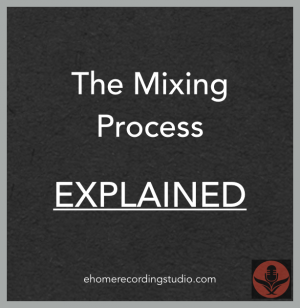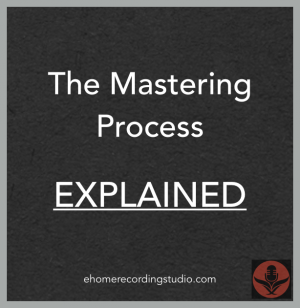
And prayed that some big-shot producer in the audience who would impressed enough to give you a shot.
But not anymore.
Today, the trend in music production is shifting more and more toward home studios.
Great music is being produced all the time in bedrooms , garages , and basements by normal folks like you and me…
Often with little more than a computer, a USB mic, and some headphones.
Record a song, post it online, watch it go viral… and you’re famous overnight.
While it’s not that EASY, it is that SIMPLE.
But before any of that can happen, you must first know the process of how music actually is recorded.
And so in today’s post, I break it down for you in 4 steps…from start to finish .

In the earliest days of the music recording…
The process was much simpler than it is today.
Entire performances were recorded in single takes, sometimes with just 1 or 2 mics.
Today though, we use a more sophisticated process known as multitrack recording …
Where each instrument is recorded separately and combined later in a “mix”.
This offers two BIG advantages :
With this new method, it meant that one man could now do alone, what used to require an entire team of engineers and musicians.
While the actual steps in the process vary from engineer to engineer…
Here’s a general guideline of how it works :
The first step is creating some kind of guide for the other instruments to follow along with.
Most people use a simple click/metronome to set a tempo. But since not all musicians can follow clicks, you could also use a pre-recorded drum loop instead.
And since not all songs have steady tempos, a third method is to create a scratch track …
Where an instrument or group of instruments are recorded as the guide, then “over-dubbed” one at a time, until the original can be deleted or “scratched“.
As any musician knows, the rhythm section is the foundation of any song. When bands play together, everyone follows the drums/bass .
It makes sense then, that these be the first instruments you normally record.
In songs that lack drums/bass, another rhythmic instrument (such as acoustic guitar), can be used instead.
Once you’ve built a good foundation, next it’s time to add to it by creating a chord structure .
Depending on the song, that could mean adding rhythm guitar , piano , synths , horns , etc.
With a basic chord progressions now in place, next it’s time to…
Since most songs use a combination of instruments to form the melody…
It makes sense that whichever ones are most dominant (usually lead vocals/lead guitar) be the ones you record first.
Then afterwards, you can fill in the gaps with all the supporting melodies.
After that, all that’s left is…
To put the finishing touches on your song, you add all those little nuances that add color and flare to the main tracks.
Common examples might include :
As I’m sure you already know, one of the hardest parts about recording all this stuff is finding competent musicians to play all these different instruments.
If you ‘re lucky, you have a band…or you at least have friends willing to help out.
However, many of us DON’T. Luckily, nowadays remote music collaboration is easier then ever with tools such as sound better or kompoz .
Once that’s done, you’re ready for the next phase …

Now that you’ve finished recording your tracks, it’s time to clean them up.
Because no matter how careful you were in the last step…
There will always be SOME mistakes that can and should be fixed…
With the amazing editing tools now available in the DAW’s of today.
Typically, editing is made up of 5 common tasks :
With arrangement , you take an overall look at everything you’ve done so far, to evaluate what works, and what doesn’t.
For example, you could :
With comping , you compare the duplicate takes of each track, and select the best one. If you like, you can even select best phrases from each take and combine them all into one “frankenstein-take”.
With noise reduction , you cut all sounds before , after , and in-between each section of audio where the instrument is playing.
This means removing :
To reduce noise further, you can add a high-pass filter beneath the lower frequency range of non-bass instruments, to remove rumbling sounds.
With time editing , you can fix off-beat notes, using one of two methods :
With pitch editing , you can shift any sour note back on-pitch, using Auto-Tune or any similar software.
Normally it’s used on vocals, but it also works well on most melodic instruments.
So that about covers the Editing Process .
Now on to the next phase…

Once the tracks are arranged exactly as you like…
The next goal is to make them blend as one cohesive unit…though the process of “ mixing “.
While mixing is an art form in itself, and can be done in many ways…
There are certain fundamental tasks that everyone does…
Common examples include :
Once you’ve used these tools to craft your mix, and it sounds great…
It’s finally time for the last step…

Before your song is ready to be mastered…
All tracks must be re-recorded down to a single stereo file…
Or “ bounced “, as it’s commonly known.
Once that’s done, various mastering techniques are used to put the finishing touches on your song…
So it sounds even better.
Common techniques include :
Once everything sounds perfect, the track is converted to its appropriate sample rate/bit depth . For example, CD audio is 44.1 kHz/16 Bits .
To put it simply, mastering is hard. And if you don’t know what you’re doing, you can easily make things worse, rather than better.
That’s why it’s standard practice for mix engineers to outsource the work to a “ mastering engineer “, rather than doing it themselves.
If you want to try it anyway, here are the software tools I recommend:
Good mastering engineers cost money, which not everyone has, or cares to spend.
Luckily though, these days there are many online freelance engineers willing to work for not much money at all, some of them even freely if you agree give away your rights.
The best platforms to ask for collaboration on a track are:
Now…having said that, the next question is…
Decades ago, when all studio recordings were intended for sale, everything was mastered.
Today however…now that many amateur recordings are done “just-because“…
Home studios will often do their own mastering, or skip it entirely. And that’s fine.
If all you do is share your music with family and friends, then who cares?
Mastering your mixes is a MUST.
By the way, if you found this post useful, I highly recommend joining our free Home Recording Secrets email newsletter where you’ll discover….
Our #1 Favorite Online Superstore: